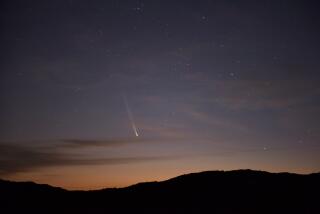Comet ISON is see-through, and that’s not good
Did Comet ISON survive its brush with the sun? Four days after the comet made its closest approach to our nearest star, the scientific consensus is “probably not.”
Yes, something did survive ISON’s harrowing Thanksgiving Day encounter with the sun. (See that puff of light emerging from the sun in the video above?) But most scientists believe it was not a comet with a nucleus, but rather a collection of pebbles and dust -- the rocky remains of the comet from the Oort Cloud.
Karl Battams, an astronomer who has been chronicling ISON’s journey toward the sun for NASA, published an obituary for the comet on Monday morning that made its end seem fairly official.
“Tragically, on Nov. 28, 2013, ISON’s tenacious ambition outweighed its ability, and our shining green candle in the solar wind began to burn out,” he wrote.
And in a conversation with the Los Angeles Times, heliophysicist Alex Young said he and his colleagues were “pretty certain that it’s gone.”
“Right before it left the field of view of SOHO and now in STEREO you can see a cloud that doesn’t have a lot of structure, and you can see stars through it,” he said. “That means there is probably no central nucleus giving off gas.”
Young said it was likely that the ice that held the bits of rock and dust that made up ISON burned up during the comet’s closest encounter with the sun or even a few hours earlier. And with that ice gone, ISON is nothing more than rocky debris.
He said the rocky remnants would travel along the comet’s orbital path for a while, but much of it would diffuse away into space, pushed away by solar particles streaming off the sun.
The Hubble telescope will take a look at the whatever remains of the comet in mid-December, once it has moved away from the sun a bit, and at that point astronomers should have a clearer idea.
But dreams of a dazzling light show in December when the comet’s orbital path will take it closest to Earth are almost certainly dashed. As astronomer Tony Phillips of Spaceweather.com put it, “A naked-eye event is out of the question.”
Secretly holding out hope for comet ISON? You’re crazy. And I am too! Follow me on Twitter for more like this.
Also:
Comet ISON’s perilous encounter with the sun
Found: A never-before-seen asteroid with six comet-like tails
How koalas make a mating call that ought to come from an elephant







